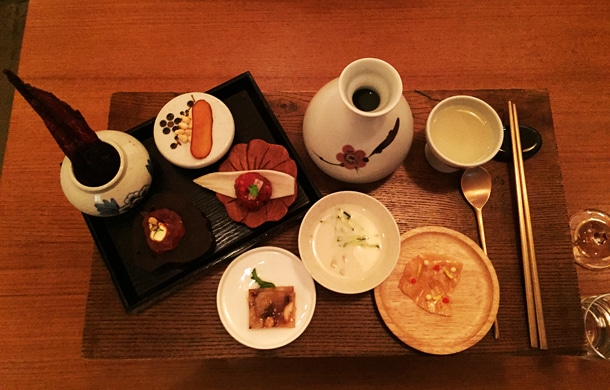Korean food fest rethinks traditions: World Hansik Festival celebrates innovation and creation in cuisine
The image of Korean food used to be a tabletop filled with a bowl of rice, soup and endless small side dishes, accompanied by a spoon and a pair of chopsticks.
However, that stereotypical image has been challenged by hansik, Korean food in Korean, which is more versatile and familiar to those who without much experience with Korean food, thanks to the World Hansik Festival.
The new event, different from other similar festivals, tries to include a variety of variations of Korean food under the name of hansik. The broader understanding of what makes hansik allows visitors to not feel awkward about eating Korean food with a fork and knife, and expose themselves to Korean ingredients in dishes presented on western-style plating.
“The festival tries to make Korean food culture that anyone in the global community can be a part of with a variety of programs which include traditional style Korean food and modern trends in cooking Korean food,” said the Korean Food Foundation, which put together the festival that ends Saturday along with the Ministry of Agriculture, Food and Rural Affairs.
While tasting the food cannot be missed at any food-related event, this festival also focuses on having food be the inspiration in the creation of other forms of arts. Besides cooking classes and panels of culinary professionals on how to better spread Korean food in the future, celebrity chefs and entertainers will come together to hold a food concert.
Edward Kwon, who has been actively involved in creating easily accessible Korean dishes for foreigners in preparation for the Pyeongchang Winter Olympic Games in 2018, came onstage yesterday with singer Eric Nam, pansori (traditional Korean singing style) singer Lee Jin-woo, and chef Tony Yoo at Korean restaurant 24 Seasons at Blue Square in Hannam-dong. The free event in an area where not only locals but also expats often visit to eat and hang out showed that presenting food and music together can also engage someone to become more intrigued in learning and eating Korean food, instead of just bringing a dish to a diner that doesn’t have much understanding of hansik.
It is not too late to look for restaurant options to taste the food, as the festival also released the list of fine Korean restaurants for people with different budgets. At 50 local restaurants that serve either traditional or modern Korean food in both upscale or casual settings, diners can have opportunity to taste new flavors created with local ingredients. A concurring event called “Korea Gourmet” is also going on until Saturday and restaurants will be serving special dishes.
“Inviting young people to enjoy Korean food on an everyday basis is as important as keeping the traditional way of cooking and maintaining the elements that constitute hansik,” said chef Kim Min-ji of modern Korean restaurant Min’s Kitchen. “One way I try is serving food with a different plating technique whilst keeping the original taste of what’s known as traditional, so that young people can be tempted to spread the word on social media and grow to expand their expectations of what Korean food [looks like.]”
Another local restaurant Kwon Sook Soo took the traditional way of setting up a drink and food together and applied it to make its own amuse-bouche, small bites served before a meal starts to bring out the appetite.
The “Korea Gourmet” event is only happening in Korea, but the long-term plan is to expand this festival globally.
In that case, the foundation may also work with Korean restaurants overseas to come up with more innovative yet comfortable Korean-style food easily made with ingredients from overseas countries.
For more information, visit the festival’s website at hansikfestival.com.
BY LEE SUN-MIN [summerlee@joongang.co.kr]
(Featured Image: Juansang, a table filled with an alcoholic beverage and paired dishes, has become the motif at local Korean restaurant Kwon Sook Soo to make amuse-bouche before the actual meal starts to stir the appetite of diners. [LEE SUN-MIN])


